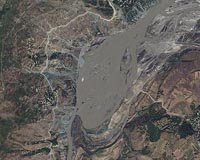| . |  |
. |
Ottawa (AFP) May 5, 2010 A Canadian ecologist has discovered the world's largest beaver dam in a remote area of northern Alberta, an animal-made structure so large it is visible from space. Researcher Jean Thie said Wednesday he used satellite imagery and Google Earth software to locate the dam, which is about 850 metres (2,800 feet) long on the southern edge of Wood Buffalo National Park. Average beaver dams in Canada are 10 to 100 metres long, and only rarely do they reach 500 metres. First discovered in October 2007, the gigantic dam is located in a virtually inaccessible part of the park south of Lac Claire, about 190 kilometres (120 miles) northeast of Fort McMurray. Construction of the dam likely started in the mid-1970s, said Thie, who made his discovery quite by accident while tracking melting permafrost in Canada's far north. "Several generations of beavers worked on it and it's still growing," he told AFP in Ottawa. Mike Keizer, spokesman for the park, said rangers flew over the heavily forested marshlands last year to try to "have a look." They found significant vegetation growing on the dam itself, suggesting it's very old, he said. "A new dam would have a lot of fresh sticks," Keizer explained. "This one has grasses growing on it and it's very green." Part of the dam may have been created by naturally felled trees, and the beavers "opportunistically filled in the gaps." Thie said he recently identified two smaller dams sprouting at either side of the main dam. In 10 years, all three structures could merge into a mega-dam measuring just short of a kilometer in length, he said. The region is flat, so the beavers would have had to build a massive structure to stem wetland water flows, Thie said, noting that the dam was visible in NASA satellite imagery from the 1990s. "It's a unique phenomenon," he said. "Beaver dams are among the few animal-made structures visible from space." North American beavers build dams to create deep, still pools of water to protect against predators, and to float food and building materials. A 652-meter structure in Three Forks in the US state of Montana previously held the record for world's largest beaver dam. Thie said he also found evidence that beavers were repopulating old habitats after being hunted extensively for pelts in past centuries. "They're invading their old territories in a remarkable way in Canada," he said. "I found huge dams throughout Canada, and beaver colonies with up to 100 of them in a square kilometer." "They're re-engineering the landscape," he said.
Share This Article With Planet Earth
Related Links Water News - Science, Technology and Politics
 Tajikistan dam project hit by controversy
Tajikistan dam project hit by controversyDushanbe, Tajikistan (UPI) Apr 27, 2010 Tajikistan's plan to ease its chronic electricity and water shortages by building a gigantic dam has run into problems mainly because of the government's unusual fundraising approach. After an unsuccessful attempt at partnership with Russia, the country's colonizer in the former Soviet Union, the government embarked on a program of encouraging - critics say pressuring - every Tajik to ... read more |
|
| The content herein, unless otherwise known to be public domain, are Copyright 1995-2010 - SpaceDaily. AFP and UPI Wire Stories are copyright Agence France-Presse and United Press International. ESA Portal Reports are copyright European Space Agency. All NASA sourced material is public domain. Additional copyrights may apply in whole or part to other bona fide parties. Advertising does not imply endorsement,agreement or approval of any opinions, statements or information provided by SpaceDaily on any Web page published or hosted by SpaceDaily. Privacy Statement |